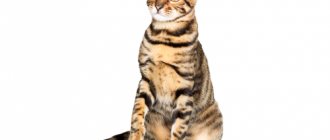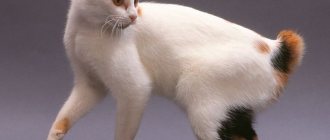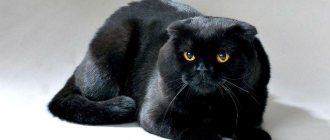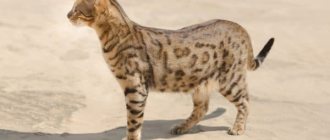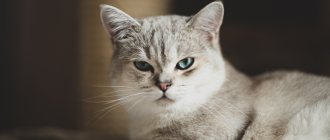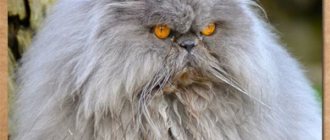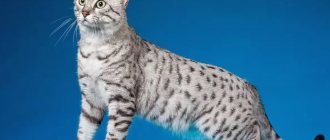For most ordinary people, a cat is a four-legged meowing creature that lives next to a person. Basically, they differ only in appearance: color, type of muzzle or long hair.
The variety of cat breeds is multifaceted, among them there is a breed of cats with short legs, with long or completely lost hair (see what is the name of a cat breed with short legs). But there is a very unique breed with a tail that is in its infancy, or completely missing.
It is not stopped at birth like in dogs, but is a distinctive elite feature. Many clients are willing to pay big money for this originality.
Origin of breed characteristics
The most interesting legend about the origin of the breed concerns one ancient cat whose tail was pressed under the door due to constant lateness. This action occurred regularly, so that each new litter of kittens was born with shorter tails, until the resulting appendage was reduced to a few vertebrae.
Since then, short-tailed cats have had creases and knots on their short stumps, which they inherited from their ancestors.
The following myth classifies representatives of short-tailed breeds as descendants of the lynx family. There are indeed common features in their appearance that can convince anyone of the validity of such conclusions. Even the chromosome map of two species contains 38 elements - the most important fact from supporters of such a theory.
The next hypothesis, unlike previous stories, looks more plausible. The kittens were born with normal tails, but the mother cats chewed them off because the cubs did not fit in the cramped den.
It was by the tail that the predator could pull the kitten out of the hole. Later, a natural mutation occurred, as a result of which short-tailed breeds appeared.
And the last version, which is related to genetics. By a strange coincidence, all tailless breeds originate either on island territories or in states with a closed way of life.
Representatives of the most ancient breed of cats with a short tail - Japanese Bobtails - came to the islands from Ancient China. For several centuries they lived in isolation. Under such conditions, it is possible to launch the natural process of inbreeding (inbreeding), which can cause genetic abnormalities.
At the other end of Europe, off the coast of Ireland, on the Isle of Man, a similar story happened. Here, local cats with short tails have been known for several centuries, but they only got outside their territory at the end of the 19th century, when they represented an already established and stable group.
This is interesting! In Bulgaria, cat breeds with short tails are believed to originate from Gabrovo. Stingy locals shortened the long tails of their pets in order to quickly close the door behind them and prevent cold air from entering the house.
Variety of bobtails
There are several subspecies of cats belonging to the bobtail breed. Let's list the main features of different bobtail cats and make characteristics of the breeds:
| Japanese | Kuril | Karelian | American | Mekong | |
| Head | The shape is an equilateral triangle, but in appearance it appears long and elongated. The nose is long and wide. High cheekbones. | Large, trapezoidal in shape, with smooth contours. The muzzle is wide. | It has the shape of an isosceles triangle. The profile is almost straight. The forehead and cheeks are flat. The muzzle and chin are narrow. | Wedge-shaped, with rounded contours. Proportional to the body. The muzzle is wide. Clearly prominent cheeks and mustache pads. The nose is wide, with a small hump on the bridge of the nose. | Round shape. Almost flat on top. The muzzle is oval. The nose is “Roman” (wide with a hump). |
| Ears | Large, widely set. Pointed upward. | Medium in size. Wide. Quite widely set. The ends are rounded. | Large, high set, vertical. | Medium or slightly larger in size with slightly rounded ends. Tassels on the ears are a desirable element. | Large, wide at the base. The tips are slightly rounded. Set high and laid back slightly. |
| Eyes | Large, oval. In profile you can see that they have a pronounced slope. The eyes are in harmony with the color, although blue-eyed individuals and even those with different eye colors are acceptable. | Round, widely set. The color is in harmony with the color. | Oval shaped, close set. The color matches the color. | Large, almond-shaped. Color may not correspond to color, with the exception of mink, sepia and colorpoint colors. | Large, oval, bright blue. |
| Body | Medium size. Graceful, long. The muscles are developed. | Compact, muscular, with a slightly arched back and raised croup. | Medium size, not stocky or elongated. | Medium size. Muscular. The chest is wide. | Medium, muscular, but at the same time graceful. |
| Legs and paws | Long, slender, strong. The hind ones are much longer than the front ones, which is visible to the naked eye. Oval shaped paws. | Strong. The hind legs are longer than the front ones, the legs are rounded. | Medium length and strong, hind legs slightly longer. The paws are round in shape. | Proportional to the body, strong. In long-haired individuals, tufts of hair between the toes are welcome. The paws are large and round in shape. | Average, slim. Oval shaped paws. |
| Tail | Not longer than 7 cm, but clearly visible. May consist of one or more bends and corners. | From 3 to 8 cm excluding wool. It must have creases and bends, one or more knots in various combinations. | From 4 to 13 cm. With kinks or curved. | From 2.5 to 8 cm. | Must have at least 3 vertebrae. Hooks and knots on the tail can be in any combination. |
| Wool | Can be of any length: short, extended and long. The undercoat is weakly expressed. The hair on the front part of the body may be shorter than on the back. It is desirable to have tufts in the ears and legs. | Middle length. The undercoat is weakly expressed. It is desirable to have a “collar”, “jabot”, “pants”, ear brushes and tassels. | Short or medium length. | There are short-haired and long-haired. In both cases, the coat is very thick, the undercoat is moderately developed. In individuals with long hair, increased shaggyness is observed on the chest, paws, belly and tail. | Short, silky. The undercoat is weakly expressed. |
| Color | All colors are acceptable, except chocolate, lilac, colorpoint, ticked tabby. The most common colors are bicolor and tricolor. | All colors are recognized except chocolate, lilac, cinnamon, fawn (including tabby, bicolor, tricolor), and colorpoint. | All colors are recognized except chocolate, lilac, cinnamon, fawn (including tabby, bicolor, tricolor), and colorpoint. | May vary. The most preferred coat color is tabby. | Colorpoint of any point color without white. The paws, tail and muzzle are darker in color. |
| Weight | 2.5-5 kg | 3-6 kg | 2.5-6 kg | 3-8 kg | 2.5-6 kg. |
| Height at withers | Up to 32 cm | Up to 30 cm | Up to 28 cm | Up to 30 cm | Up to 30 cm |
| Price | From 200 to 500$ | From 70 to 500$ | Up to $1000 | From 500 to 1300$ | From 70 to 200$ |
| A country | Japan | Russia | Russia | USA | Thailand |
Japanese Bobtail
The history of the appearance of Japanese bobtails dates back to approximately the 16th century. There is a version that these cats arrived in Japan from India, while bypassing the territory of China. Representatives of this breed can be seen in ancient paintings and engravings of the imperial palace, and their descriptions are also found in legends and myths.
Since ancient times, Japanese bobtails have lived in Buddhist temples and in the chambers of the Emperor of Japan.
Tailless cats were highly respected and loved in Japan. The ancient Japanese believed that cats with long tails brought bad luck and could turn into werewolves. Therefore, they cut off part of the tail, leaving only a “bunny tail”. There is speculation that centuries of tail trimming led to a mutation that caused the development of the unusual Japanese bobtail.
The breed received its modern development after World War II, when it was brought to the United States. Japanese bobtails received official recognition in 1976.
In ancient Japanese paintings you can often see tailless cats.
Japanese Bobtails have a balanced temperament; the cats are friendly but independent. The Japanese have a developed intellect and get along easily with children.
Kurilian Bobtail
The history of the Kuril (sometimes you can hear Kamchatka) bobtail can be traced back to the 19th century. The ancestors of the bobtail lived on the Kuril Islands, the Kamchatka Peninsula and Sakhalin Island. According to one version, these cats directly descended from an ancient domestic breed - Japanese bobtails. Having arrived in the Kuril Islands several centuries ago, they became wild again and acquired new hereditary characteristics. According to another version, Kurils originated as a result of natural crossing of Japanese bobtails with Siberian cats brought to the Kuril Islands by settlers.
In the twentieth century, unusual cats began to attract the attention of geologists and military personnel arriving on the Kuril Islands; they often tamed them and took them with them to the mainland. For a long time these cats were not distinguished from Japanese bobtails, which is why the development of the breed began only in 1980. In 1995, the Kurilian Bobtail was officially recognized by the international federation WCF.
The Kuril Bobtail lived for many years on the Kuril Islands and was unknown to the world
The Kurilian Bobtail is a very loyal pet. He chooses his owner himself and considers him to be the leader of the pack. They remember commands very well, but carry them out of their own free will. Kurilians love to walk in the fresh air, and like American Bobtails, they love outdoor games. In addition, smokers have virtually no smell.
The Kurilian Bobtail is a big fan of hunting. He will catch all the rats and mice in the area, and then he will deal with insects and even fish. Far Eastern cats are not afraid to dive, since the specific structure of their ears allows them to be folded in a special way, preventing water from getting inside.
Kurilian Bobtail cats are smart, highly trainable and courageous. They can easily replace a dog in terms of devotion to the owner and sociability.
Karelian Bobtail
The Karelian Bobtail is considered a descendant of the Norwegian wild cat. It was discovered in Karelia in the 90s of the twentieth century. The breed arose spontaneously and was preserved thanks to the beliefs of local residents, according to which this cat brings happiness and good luck.
The breed was first shown at an exhibition in 1987. And three years later, cats were officially recognized. Despite all the efforts of breeders and external beauty, Karelian bobtails are considered very rare. Few breeders undertake their breeding.
Karelian Bobtails are very beautiful cats
Karelian Bobtails have a friendly and affectionate disposition, they are unobtrusive and have a good sense of people’s moods. They adapt well to any living conditions and do not experience stress when moving or traveling.
American Bobtail
In the genes of the American Bobtail you can find Siamese cats, Redgalls, Manx cats and simply outbred short-tailed cats. A standard was developed in 1970, and the American Bobtail received worldwide recognition in 1989.
The American Bobtail has a diverse combination of breeds in its genes
The American Bobtail is a robust cat with a characteristic naturally short tail. The tail must be present; its absence indicates the presence of a disease of the spine and joints. Thanks to his athletic build and specific facial features, the American gives the impression of a wild animal.
American Bobtails are very calm, patient and have an easygoing and gentle character. They love their owners and do not tolerate loneliness well. Americans are patient with other animals, including dogs.
American Shorttails have a gentle and friendly character.
In the USA, American Bobtails are widely used in therapy because they are very sensitive to human moods.
American cats love outdoor games, are easy to train, love communication and walks in nature. Because the American Bobtail breed is young and still developing, personality traits may change in future generations.
Mekong or Thai Bobtail
The Mekong or Thai Bobtail is an ancient cat breed in Thailand. According to legend, this cat lived in aristocratic families, and its short tail was used for stringing and storing jewelry. Presumably this breed appeared as a result of mutations of Siamese cats.
Once upon a time, the Mekong Bobtail was prohibited from being exported outside the borders of Thailand. Fortunately, at the beginning of the twentieth century, several Mekong kittens were presented to the English ambassador.
Later, felinologists worked on the breed, and with the beginning of the 21st century, the Mekong Bobtail standard was established. Currently, this is a rather rare breed, but the fashion for it is gaining momentum.
Rich Thai aristocrats hung their jewelry on the tails of Mekong bobtails.
Mekong Bobtails resemble dogs in some tastes and habits. For example, they calmly walk on a leash, love to play, bring things to their owner in their teeth, and when he leaves, they guard his things and do not allow strangers to take them. Mekongs are very patient with children and get along well with other pets.
General characteristics of tailless cats
The names of cat breeds with short tails almost always contain the designation "bobtail". The exception is the Cymric and Manx - two branches of the same pedigree group that differ only in the length of their coat.
All native cats with short tails are similar to each other:
- Quite large animals on high paws, the body is covered with thick water-repellent fur.
- The hind legs are longer than the front ones.
- They learn easily and have the ability to remember acquired knowledge for a long time.
- They quickly become attached to people.
- They are not afraid of water, enjoy swimming and fish well.
- Active, mobile, with a large reserve of strength.
- Cats with short tails are very responsible in raising their offspring.
- These animals mature very early, especially Manx and Cymric. By six months they are already able to give birth.
Cymric cat breed
It is unfair to call these cats completely tailless. The length of the tail can be arbitrary, but less than that of representatives of other breeds. Ideally, the tail should not fall below the hock joint of the hind legs or be less than 3-5 cm.
Individual requirements are provided for by the standards of international expert associations.
Bobtail breeding
Bobtails are prohibited from crossing with cats of other breeds. To breed these cats, you need to adhere to the following recommendations:
- A cat should go through 1-2 heats before mating. In this case, the cat must not be younger than 1 year and its body must be fully formed. The cat must also be at least 1 year old. The optimal age is one and a half years.
- At least one of the partners must already be experienced in this matter;
- Both pets must be healthy and vaccinated 14 days before;
- You should not wash your cat before mating, so as not to deprive her of her natural scent;
- The date should take place on the cat’s territory, the cat is left there for 3-5 days;
- Mating is prescribed on the 2-3rd day of estrus.
In addition, when choosing a partner, you need to pay attention to the length of the tail. If a cat's tail reaches 8-12 cm in length, then a cat's tail should be much shorter. This produces offspring with a tail from 3 to 8 cm.
Bobtail baby
Pregnancy and childbirth usually proceed without any special features. But if the breeder is inexperienced, it is better to play it safe and arrange for the presence of a veterinarian.
List of cat breeds without a tail
In first place are the aborigines, who became the ancestors of today's cats with short tails.
Japanese
Bobtail (cat without a tail) is a breed with a thousand-year history. These animals have a flexible, muscular body, elongated limbs and a short tail with a fur pompom at the end.
In Japan, such a cat is considered a cult animal for its unsurpassed hunting skills.
Kuril
A group that formed in the Far East. It is obvious that the local bobtail breed developed with the participation of Japanese cats. Only in the last quarter of the last century did the Kurilian Bobtail first appear on the Eurasian continent.
This breed has a standard wild coloration and a distinctive pom-pom tail. It is stably inherited by offspring and does not cause health problems.
Manx and Cymric
Elders of a tailless tribe from Old Europe. The population is interesting for two reasons:
- Small kittens are born with a short tail or no tail at all. There are 4 categories that indicate the length of the appendage (rumpy, riser, stumpy and longy). The first of them indicates taillessness, and the final one indicates normal length.
- Secondly, the breed provides options for making a parental pair - in two individuals with the tailless gene, the kittens die. Therefore, one of them must be tailed.
The difference between Manx and Cymrian cats is the length of the hair. Initially, they were short-haired, and experts culled long-haired animals. But when cats with long hair formed a large group, they were given the name Cymric and registered as a separate breed.
Short-tailed Manx cat
Karelian Bobtail
Another representative of the Russian aboriginal breed from the coast of Lake Ladoga. Initially, it was classified as a species of Kuril, but later geneticists revealed that they lack common characteristics. Since then, Karelian tailless seals have been considered a separate species.
Diseases
Bobtail cats are in good health and have not been diagnosed with any genetic diseases. However, some bobtail breeders note that the absence of a tail can cause inflammation of the anus and rectal prolapse. Therefore, it is important to examine your cat from time to time to identify redness or cracking in the anus in advance. Otherwise, all bobtails need the usual procedures for all cats - preventive vaccination and treatment for parasites.
The life expectancy of bobtail cats is quite high. With proper care, they live for more than 15 years.
Mekong Bobtails are the longest-living breed not only among bobtails, but also among cats in general. Their lifespan is 20-25 years.
Mekong cats are the longest-livers of the cat world.
Hybrid breeds
In the 20th century, on the basis of naturally developed breeds, new types of mestizos and hybrids of cats with short tails appeared.
- The Mekong Bobtail is a Russian descendant of the ancient Siamese tailless animals. Due to the acromelanic coloring characteristic of Asian cats, it is called the Thai Bobtail.
- Pixie bob in a spotted color, with lynx tufts on the ears and a characteristic predatory appearance. He was brought to the USA at the end of the last century from the parent line of wild forest short-tailed cats.
- The American Bobtail is another “representative” of the New World. Its selection took place in the mid-60s. According to one version, the ancestors of this breed were lynxes and local short-haired cats.
Mekong bobtail
Pixie-bob breed
American Bobtail cat
Tailless cat breeds are not widespread and are considered quite rare species. And the animals that were born as a result of recent experiments (snow bob, toy bob, twisty, oriental bobtail, oohee bob) are generally familiar to cat lovers only from photographs and rare reports from exhibitions.
Diseases
The immunity of cats of this breed is enviable. But they also have weaknesses.
The first thing you should pay attention to is the ponytail, or more precisely, the area under it. At the very first inspection, find out whether there are any cracks, irritation or ulcers.
Such a short length is a prerequisite for the occurrence of an inflammatory process or prolapse of the anus. The Kurilian Bobtail should be examined regularly, and if damage is found, take it to a veterinarian for examination. Remember: if you feed your cat poorly, he will develop this kind of illness quickly.
Ordinary sea buckthorn oil helps to deal with small cracks: they lubricate the anus area with it and make sure that the cat does not lick it right away.
The second nuance: in Kuril Bobtails, the urine pH is significantly different from the urine of cats of other breeds (7-7.5 versus the usual 6-6.5). Therefore, they rarely suffer from urolithiasis of the alkaline type.
Timely and regular vaccination will help protect your pet from a number of diseases - rabies, rhinotracheitis, panleukopenia, calicivirus, leukemia, peritonitis. The kitten receives its first vaccinations at the nursery, but in the future you will have to learn the vaccination calendar and take your pet to the doctor yourself.
Information about the procedures is entered into the veterinary passport. You should not vaccinate yourself (if you do not have the appropriate education: a mistake can lead to serious consequences. Do not try to vaccinate your pet against all diseases at once: this is too much stress on the immune system!
Pros and cons of tailless cats
Keeping tailless cats does not differ from the rules that have been established for other breeds:
- Weekly brushing (daily during shedding period).
- Swimming does not create problems for owners of aboriginal bobtails - the animals love water and willingly enter it.
- All short-tailed cats are attached to people and devoted to their owner.
- Stable immunity and good genetics mean that representatives of these breeds are not prone to hereditary diseases.
- Short-tailed cats are not long-livers, but with satisfactory care, all breeds consistently live up to 15 years.
Many people consider short-tailed cats to be strange, not quite ordinary animals. In fact, representatives of tailless groups are distinguished by their outstanding intelligence and good health. If one day a person gets a cat with a small pom-pom tail, then in the future he will never become a fan of another breed.
How to get beautiful offspring
People who breed cats with short tails are very fond of this breed. For females that have a tail of eight to two centimeters, short-tailed males are selected. This may result in bobtail offspring.
The first mating can be carried out when the cat is one and a half years old, provided that estrus has already appeared. To do this, two periods of the onset of estrus are skipped and only then the female can be mated.
Classification of shorttails
Basically, all tailless or short-tailed pets in the official nomenclature are called bobtails: bob is translated from English as pompom, and tail is tail. The prefix in front only indicates the place of origin of the breed. There are also hybrids - just “beans”.
Manxes are included in a separate nosological group (Manx is translated as from the Isle of Man). The internal classification divides all representatives into 4 subgroups:
- rumpy (rumpy) - no tail at all;
- riser (riser) - a very small process consisting of one vertebra, as a rule, it cannot be seen behind the hair;
- stumpy - the tail is much shorter than that of standard cats;
- tiled or longy is the most standard rudiment.
Pixiebob
There is also another breed of cat without a tail. Its name is pixie bob. The progenitors of this species are wild forest and peaceful domestic cats. The goal of working with such material for breeders was to obtain domesticated lynx. The result of the process was a breed of cat that resembles a wild animal; the animal’s tail has the appearance of a stump. A significant disadvantage of the pixie bob is the frequent presence of extra toes on its paws. This anomaly does not affect his health or communication skills in any way. The cat fully meets the standards of a pet. The pixie bob has avid friendly relationships with children; the pets do not show any aggression or malice.
Description
The tail is not only a gorgeous property of the entire cat family. It is a versatile body part that helps with maneuvers and balance while climbing fences. It is also necessary to express the prevailing mood and effectively combat rising anxiety. How then do cat breeds exist without a tail in this difficult and hectic world? The lack of continuation of the ridge is not a simple whim or deceit of nature; such injustice is inherent in the genes of graceful animals. Such pest genes are dominant, and a fetus that has two identical carriers dies without seeing the world. To produce offspring, one of the parents must have a tail.
